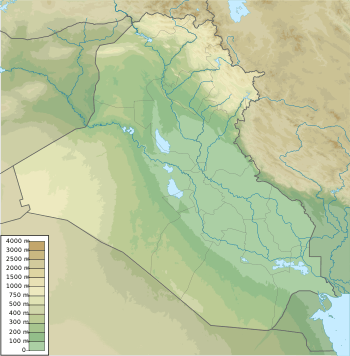Kuara (Sumer)
Kuara (also known as Kisiga, Ku'ara, modern Tell al-Lahm site, Dhi Qar Governorate, Iraq) is an archaeological site in Dhi Qar Province (Iraq). According to the Sumerian King List, Kuara was also the home of Dumuzid, the fisherman, the legendary third king of Uruk .[1] The city's patron deity was Meslamtaea (Nergal).[2] In Sumerian mythology, Kuara was also considered the birthplace of the god Marduk (Asarluhi), Enki's son. The cults of Marduk and Ninehama were centered in Kuara.[3][4]
Kuara, Kisiga, Ku'ara | |
 Shown within Iraq | |
| Location | Dhi Qar Governorate, Iraq |
|---|---|
| Region | Mesopotamia |
| Coordinates | 30°50′N 46°20′E |
| Type | tell |
| Site notes | |
| Excavation dates | 1855, 1918, 1940s |
| Archaeologists | J.E. Taylor, R. Campbell Thompson, F. Safar |
History of archaeological research
The location was excavated for a few days in 1855 by J. E. Taylor. He found a few inscribed bricks, and a single cuneiform tablet.[5][6] While working at Eridu for the British Museum in 1918, R. Campbell Thompson excavated there briefly.[7] In more modern times, Fuad Safar conducted soundings at Kuara.[8]
Kuara and its environment
Tell al-Lahm is located on the western bank of the mouth of the Euphrates, about 30 kilometres (19 mi) southeast of Ur.[9] The site consists of two tells or settlement mounds, with some peripheral ridges, near a dry canal bed.
Occupation history
Kuara was established ca. 2500 BC, during the Sumerian Early Dynastic II period. It was a seaport to the Persian Gulf, and traded with the port of Dilmun.[10] In 709 BC, the Assyrian king Sargon II was trying to capture Marduk-apal-iddina II, who fled to Kuara, whereupon Sargon's army laid siege and destroyed the city.[11][12] Alluvial soil carried by the Euphrates continually extended the land farther into the Persian Gulf; thus the modern site is far from the sea, even though it was a sea port 4500 years ago.
See also
- Cities of the Ancient Near East
References
- Beaulieu, Paul-Alain (2003) The Pantheon of Uruk During the Neo-Babylonian Period. Brill. ISBN 90-04-13024-1, p. 114
- Sumerian City-States Archived 2007-08-18 at the Wayback Machine
- A.R. George (1992) Babylonian Topographical Texts, Peeters. ISBN 90-6831-410-6
- Black, Jeremy A (2004) The Literature of Ancient Sumer . Oxford University Press. ISBN 0-19-926311-6, p. 134, 365
- J. E. Taylor, "Notes on Abu Shahrein and Tel el Lahm", Journal of the Royal Asiatic Society, 15 (1855), pp. 404-415
- E. Sollberger, "Mr. Taylor in Chaldaea", Anatolian Studies, 22 (1972), pp. 129-139
- R. Campbell Thompson (1920) The British Museum excavations at Abu Shahrain in Mesopotamia in 1918, Oxford.
- Fuad Safar, "Soundings at Tell Al-Laham", Sumer, 5 (1949), pp. 154-172
- Frame, Grant (1992) Babylonia 689-627 B.C.: A Political History. Nederlands Historisch-Archaeologisch Instituut te Istanbul. Istanbul, Turkey. 396p. ISBN 90-6258-069-6, p.162
- Howard-Carter, Theresa, "Dilmun: At Sea or Not at Sea?: A Review Article", Journal of Cuneiform Studies, 39 (1987), pp. 54-117
- Boederman, John (2002) The Cambridge Ancient History. Cambridge University Press. ISBN 0-521-22717-8, p. 99
- Potts, Daniel T. (1997) Mesopotamian Civilization: The Material Foundations. Cornell University Press. ISBN 0-8014-3339-8, p. 191
Further reading
- H. W. F. Saggs, "A cylinder from Tell Al-Laham", Sumer, 13 (1957), pp. 190–195